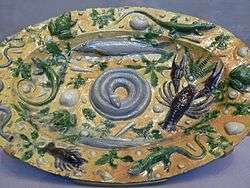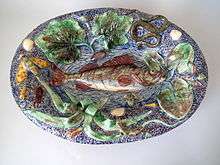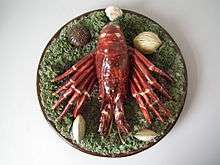Palissy ware
Palissy ware is a 19th-century term for ceramics produced in the style of the famous French potter Bernard Palissy (c. 1510–90), who referred to his own work in the familiar manner as rustique ("in the rustic style"). It is therefore also known as rusticware. Palissy's distinctive style of polychrome lead-glazed earthenware [1] in a sombre earth-toned palette, using naturalistic scenes of plants and animals cast from life,[2] was much imitated by other potters both in his own lifetime and especially in the 19th century. In this revival, pottery in Palissy's style was produced by Charles-Jean Avisseau of Tours, who rediscovered Palissy's techniques in 1843, his relatives the Landais family of Tours, Georges Pull of Paris, Maurice, and Barbizet.

The number of 16th-century pieces attributed to Palissy himself is now much less than in the past, and attributions tend to be cautious, as for example: "workshop or imitator or follower of Palissy".


Portuguese Palissy ware was produced by the potteries of Mafra, Jose A. Cuhna, Alves, José Francisco de Sousa, Cezar, Herculano Elias, and Augusto Baptista de Carvalho.[3] Twentieth-century reproductions are extremely common.[4] it is now difficult to identify which 16th-century works in the rustique manner are actually from Palissy's own workshop except by comparison with either fragments excavated in 1878 from remains of the grotto that he certainly decorated at the Tuileries Palace for Catherine de' Medici, who called him to Paris in 1566[5] or from excavations at the site of his Paris workshop in the Palais du Louvre. Many museums have now become cautious in their attributions.
This distinctive style of pottery is characterized by three-dimensional modeled, often aquatic, animals such as snakes, fish, lizards, frogs, and snails arranged onto large platters (wall plates, wall platters, chargers). Typically, each component is modeled and painted individually.
Palissy ware is also the name given [6] by Minton & Co for the earthenware later known as 'majolica', decorated with a mostly new range of coloured glazes.
Notes
- Bouquillon, A & Castaing, J & Barbe, F & Paine, S.R. & Christman, B & Crépin-Leblond, T & Heuer, A.H.. (2016). Lead-Glazed Rustiques Figulines [Rustic Ceramics] of Bernard Palissy [1510-90] and his Followers: Archaeometry. 59. 10.1111/arcm.12247. "Summary: Analysis confirms that Palissy used coloured lead glazes, lead silicates with added metal oxides of copper [for green], cobalt [for blue], manganese [for brown and black] or iron [for yellow ochre] with a small addition of tin [for opacity] to some of the glazes."
- Hanna Rose Shell, "Casting Life, Recasting Experience: Bernard Palissy's Occupation between Maker and Nature" (2004) Project MUSE.
- Marshall P. Katz, Portuguese Palissy Ware: A Survey of Ceramics from Caldas da Rainha, 1853–1920 (1999).
- John Fleming and Hugh Honour, The Penguin Dictionary of the Decorative Arts (1977), s.v. "Bernard Palissy".
- Conserved in the Musée du Louvre.
- Arnoux, Leon (1877). "Pottery, British Manufacturing Industries". Gutenberg. pp. 392–394. "The name of majolica is now applied indiscriminately to all fancy articles of coloured pottery. When, however, it is decorated by means of coloured glazes, if these are transparent, it ought to be called Palissy ware, from the name of the great artist who used these for his beautiful works."
- Victoria and Albert Museum, London https://collections.vam.ac.uk/item/O11488/chestnut-dish-minton-hollins-co/